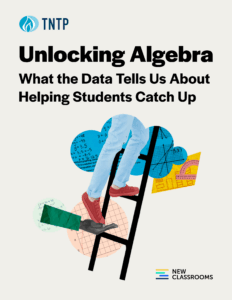Update, 3/26/20: Since we first published this post, school closures in response to the COVID-19 (coronavirus) outbreak have become the norm across the country. It’s also clear that in many communities, schools will remain closed for months—or even for the remainder of the school year. In addition to the list of home learning resources and strategies below, we’re compiling guides to help school system leaders on a variety of topics, which you can access here.
You can also sign up to receive email updates when we add new resources.
We’re also still offering a limited number of free planning sessions for school system leaders—to help think through instructional content, staff training plans, schedules for home learning, or other resources that might be useful as you navigate this uncertainty. To learn more, email us.
Choosing Home Learning Resources: Guiding Principles
Choosing among countless virtual learning resources can be overwhelming, but you can use a few basic principles to narrow your search:
- Try to use what you’ve already been using. Teachers and students will have the most success with materials they’re familiar with. If you can leverage your existing resources virtually—especially if you’re confident in their quality—you should.
- Keep it clear and simple. Don’t overwhelm your staff and families with too many resources. Plan for about 2.5-4.5 hours of instruction per day, depending on age, and give families specific advice about when and how to use the materials you recommend. When it comes to delivering virtual instruction, don’t underestimate the power of the simplest solutions—for example, teacher-to-student phone calls.
- Make sure your plan works for all families. It’s better to take a little longer to roll out a virtual learning plan that works for families than to rush a plan that causes frustration. Be sure to think through issues like training and access to technology.
- Reading is everything. If nothing else, make sure students have access to high-quality texts (fiction and nonfiction), and stress that reading should happen every day.
Planning for Extended Closures
If your system is facing the prospect of closures that last for weeks or months, you’ll need to be clear on your goal for a long-term distance learning strategy. You’re likely facing one of two situations.
If you’ve already adopted a high-quality curriculum that teachers and students are familiar with, your goal should be creating a distance learning strategy that’s simply an extension of your existing academic strategy. That means finding the best way to deliver virtual instruction using your existing resources, and accounting for what teachers and students will need to effectively teach and access the curriculum from home.
If curriculum varies across your system, or if your teachers primarily create their own materials, your goal should be providing a simple, concrete plan to help families use resources you provide, and finding ways to connect teachers and students virtually. That means focusing on any additional support teachers will need to implement virtual learning, and any support or resources students will need to access materials at home.
The Lists
With those guiding principles in mind, we’ve created two lists of home learning resources. The standalone/short-term list has resources that don’t require extensive knowledge of a particular curriculum, for sure in the absence of a more robust curriculum or while you develop a longer-term virtual learning plan. The existing curriculum/long-term list includes high-quality curricular resources and their virtual or free offerings. Note that many of these resources require familiarity with the underlying curriculum and shouldn’t be introduced for the first time virtually. Finally, we’ve included a list of virtual platforms for connecting teachers and students
Standalone/Short Term Resources
All subjects
- Khan Academy (all grades): Video lessons and practice across a wide variety of topics at all grade levels, from preschool through graduation. Check out the step-by-step video and quick-start guide for using with remote instruction. High school math lessons, in particular, are a great accompaniment to teaher-created materials.
- NYC Department of Education “Learn at Home” materials (all grades): These standards-aligned packets are a good option for students without internet or computer access.
- Scholastic (K-8): Free lessons for all content areas.
ELA
- Reading A to Z (elementary): Encompasses Myon, Starfall, and IXL. Basic reading practice for learning readers; lean on the resources already in use in your school. Also offers authentic Spanish books.
- EPIC (elementary): Digital library for elementary students. Teachers must sign up and invite students. Also available in Spanish.
- TumbleBooks (elementary): Digital library for elementary students.
- Unite for Literacy (elementary): Digital library for elementary students.
- Time for Kids (elementary): Student articles for grades K-6; good for knowledge-building reading.
- CommonLit (upper elementary/secondary): More than 2,000 high-quality free reading passages for grades 3-12.
- Newsela (upper elementary/secondary): Nonfiction texts at different independent reading levels paired with activities, including news articles, science pieces and social studies pieces.
- New York Times writing curriculum (secondary): Flexible program for middle and high schools based on the real-world writing found in newspapers, from editorials and reviews to personal narratives and analysis essays.
Math
- Learn Zillion (all grades): Short (3-10 minute) videos intended for teacher and student use focused on targeted concepts.
- National Association for the Education of Young Children (pre-K/K): Toolkit of 20+ resources.
- Dreambox (K-8): Gamified, adaptive, online K-8 math program designed to develop mental math strategies (paper/pencil should not be used). Currently free.
Existing Curriculum/Long-Term Resources
ELA
- Core Knowledge (pre-K-5): Free downloadable core knowledge curriculua in ELA, humanities, and science. Also offers downloadable read-alouds.
- Open Up Resources (K-5): Offers family and student resources for virtual learning aligned to EL Education K-5, Bookworms K-5, and Reading with Relevance.
- Expeditionary Learning (K-8): See their collection of free online resources to support distance learning.
- Wit & Wisdom (K-8): Great Minds is sharing free, recorded daily lessons delivered by their own teachers, viewable on any device (including smartphones).
Math
- Eureka (all grades): Great Minds is sharing free, recorded daily lessons delivered by their own teachers, viewable on any device (including smartphones). If possible, send students home with their Eureka Math student books.
- Open Up Resources (K-5): Offers family and student resources for virtual learning aligned to Illustrative Math 6-8 and High School Mathematics.
- Desmos (3-12): Interactive graphing activities to help students visualize and represent mathematics across mainly secondary mathematics topics, but some elementary topics are also included in their list of featured collections here.
- Illustrative Mathematics (secondary): Teachers and students can access the materials in English and Spanish with a free Kendall Hunt account</a>; online materials include a course guide for teachers and information for parents. Kahn Academy also offers a video series designed to support the grades 6-8 curriculum. Districts looking for a long-term virtual solution should consider contacting LearnZillion, an IM-certified partner.
- Zearn (K-8): This curriculum includes a guide for distance learning.
Science
- PhD Science (3-5): Great Minds is sharing free, recorded daily lessons delivered by their own teachers, viewable on any device (including smartphones). If possible, send students home with their PhD Science module 4 logbooks.
Virtual Platforms
- Zoom: Currently free, easy to use with a computer or smartphone, lots of great features (e.g. whiteboard, screen sharing, chat). There is a learning curve, though, and students would likely need training on how to use it.
- Google Classroom: Free; highly recommended by many educators; accessible by computer, phone, and even game consoles. Many schools already have Google accounts for students, which makes this easy to access. See the guide for teachers and guide for administering assessments.
- Teacher-directed phone calls: Allows teachers to connect with students 1:1, no internet required. Teachers could create a Google Voice phone number for students to call and text. Calendly is a useful tool to quickly schedule 1:1 check-ins.







